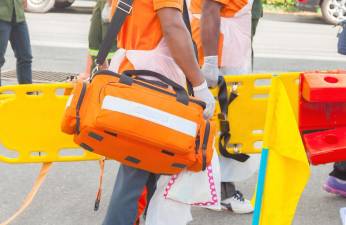County offers matching funds to develop 24/7 EMS service throughout Pike
Milford. Commissioner Matt Osterberg noted that Pike is the only county in Pennsylvania that does not have a hospital or an urgent care center.

The commissioners have a plan to match local municipalities in EMS spending, up to $2 million, to secure 24/7 coverage and improved service through Pike County.
Their plan, offered on July 27 to municipal leaders, will begin Jan. 1, 2022. Pike County Commissioner Ron Schmalzle says its goal is to create a sustainable system that provides 24/7 coverage and improved EMS service. It will develop a program that can serve as a model for other counties as legislators continue to seek new funding streams, he said.
“We recognize that this is a bridge to the future,” Schmalzle said. “Where that bridge is going, I don’t think any of us knows, or how quickly we can get there.”
While matching dollar-for-dollar up to $2 million of the municipalities’ total funding, the county will annually request, by Oct. 1 each year, confirmation of a participating municipality’s projected EMS allocation for the year ahead.
Funds will be distributed quarterly.
The program will fund Basic Life Support Service or Advanced Life Support Service. Quick Response Service will not be part of this funding. According to the Pennsylvania statute governing emergency medical services, a Quick Response Service is an operation in which an EMS agency provides emergency medical services to patients pending the arrival of an ambulance.
“If a municipality wants to do that on top of what they’re already doing, that’s up to you,” Schmalzle said.
The key piece is cooperation among municipalities, EMS agencies, and the county, which could potentially provide administrative support to help process insurance claims.
“We want this to be a cooperative effort,” Schmalzle said. “We understand that you are in charge of this, and our job is to provide you with money and some guidance if you seek it.”
Coverage voids
The county also will collect data and adjust the plan to meet the service percentages for each provider.
The county funds must be used to fund the primary municipal EMS provider, if a municipality has more than one, with the funds adjusted by the percentage of the coverage area. The money must be used to provide services, such as paid staff, contracted services, and expanded service.
Municipalities must fund their portion of the EMS allocation from the general fund, an EMS tax, grants, or a combination, and they must inform the county by Oct. 1 whether they will participate. They’re also encouraged to collaborate with existing providers or contract service to continue or expand coverage.
Municipalities are also encouraged to work together to fill coverage voids.
“I think we are the only county in Pennsylvania of the 67 that does not have a hospital or an urgent care center,” commissioners’ chair Matthew Osterberg said. “That is awful.”
Osterberg said this isn’t a one-and-one deal. The proposal is a commitment from the commissioners, who will slowly build the $2 million into the budget so that one big county tax won’t be needed to cover it.
The goal, he said, is to build up ambulance service in the region and support services that have been struggling.
Bernie Swartwood, the county’s public safety director, emphasized that coaction is crucial.
“If everybody works together at the municipal level, this system will work,” he said. “But it’s going to require everyone to step up.”
“We recognize that this is a bridge to the future. Where that bridge is going, I don’t think any of us knows, or how quickly we can get there.” Commissioner Ron Schmalzle

